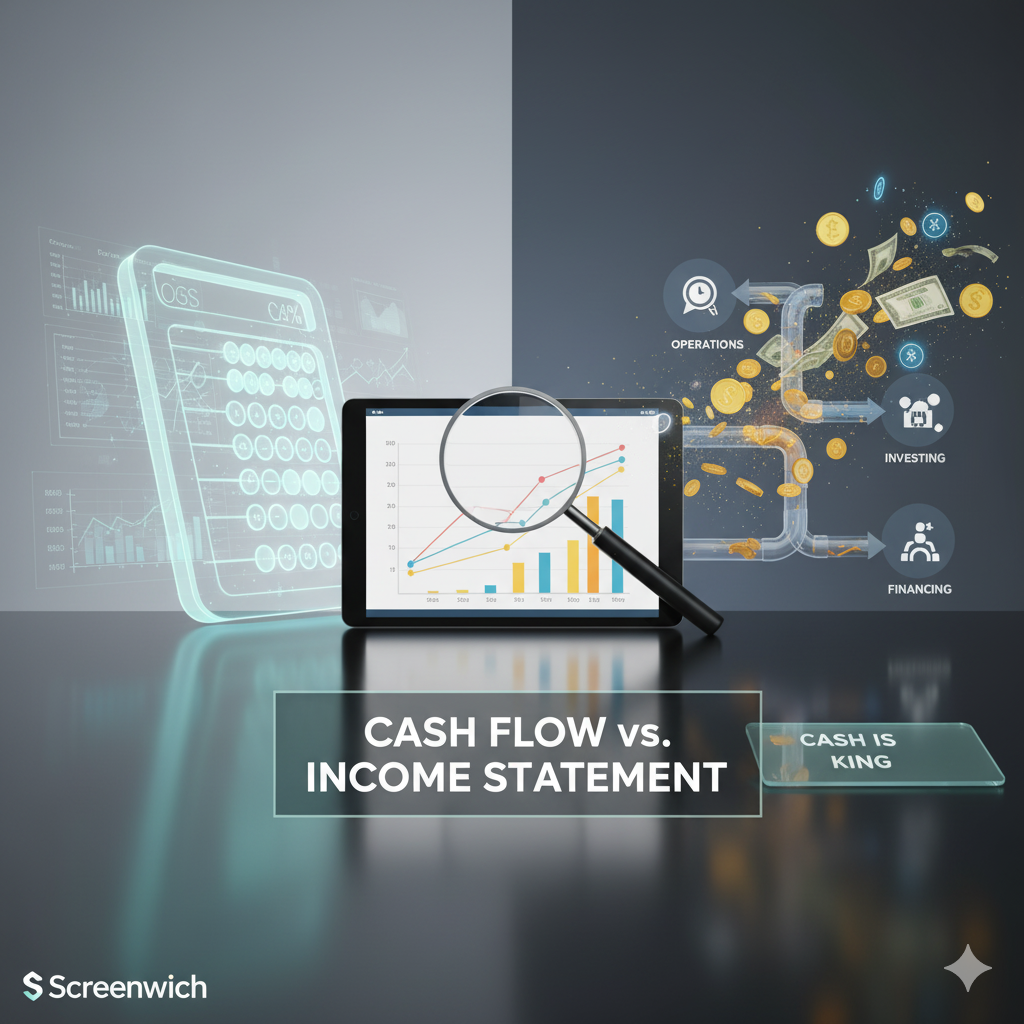The Income Statement: Profitability Over Time

Understanding a company's true financial health requires looking beyond headline profits. The cash flow statement vs income statement explained is fundamental for any serious investor. These two core financial documents offer distinct, yet complementary, views of a business. As a senior equity analyst, I stress that mastering both is non-negotiable for sound investment decisions.
The Income Statement: Profitability Over Time
The income statement, often called the Profit & Loss (P&L) statement, shows a company's financial performance over a specific period, typically a quarter or a year. It reveals how much profit a company has made.
What it Shows:
- Revenue: The total money generated from sales of goods or services.
- Cost of Goods Sold (COGS): Direct costs attributable to producing the goods sold by a company.
- Gross Profit: Revenue minus COGS.
- Operating Expenses: Costs not directly tied to production, such as salaries, rent, and marketing.
- Operating Income: Gross Profit minus Operating Expenses.
- Net Income (Profit): The 'bottom line' – what's left after all expenses, including interest and taxes, are deducted.
Accrual Accounting:
The income statement uses accrual accounting. This means revenues are recognised when earned, and expenses when incurred, regardless of when cash actually changes hands. For example, a sale made on credit is revenue, even if the cash hasn't been received yet. This provides a clear picture of a company's operational efficiency and profitability.
The Cash Flow Statement: Actual Cash Movement
The cash flow statement tracks the actual cash coming into and going out of a business over a specific period. As Warren Buffett often reminds us, "Cash is king." This statement reveals a company's liquidity and solvency – its ability to pay its debts and fund its operations.
Cash Flow from Financing Activities:
This section details cash flows related to debt, equity, and dividends. It includes issuing or repaying debt, issuing or repurchasing shares, and paying dividends to shareholders. It shows how a company raises and repays capital.
Cash Flow from Investing Activities:
This reflects cash used for or generated from investment activities. This includes buying or selling long-term assets like property, plant, and equipment (PP&E), or investments in other companies. Significant cash outflows here might indicate growth investments, while inflows could mean asset sales.
Cash Flow from Operating Activities:
This section shows the cash generated or used by a company's core business operations. It starts with net income and adjusts for non-cash items (like depreciation) and changes in working capital (e.g., accounts receivable, inventory). Strong, consistent operating cash flow is a hallmark of a healthy business.
Key Differences and Why Both Matter
The fundamental difference lies in their focus: the income statement shows profitability (accrual basis), while the cash flow statement shows liquidity (cash basis). A company can be profitable on paper but still struggle with cash, or vice versa.
- Non-Cash Items: The income statement includes non-cash expenses like depreciation and amortisation. These reduce profit but do not involve an actual cash outflow. The cash flow statement adjusts for these.
- Timing Differences: A company might make a large credit sale (revenue on income statement) but not receive cash for months. Conversely, it might pay for inventory (cash outflow) before it's sold (expense on income statement).
Charlie Munger taught us to understand the underlying business economics. While net income is a useful starting point, Bill Ackman often emphasises free cash flow as the true measure of a company's ability to create value. A company with strong earnings but weak operating cash flow is a red flag, suggesting potential accounting tricks or poor working capital management.
Using Both for Robust Stock Analysis
For comprehensive stock analysis, you must examine both statements together. They provide a complete financial narrative.
- Consistency: Look for consistency between net income and operating cash flow. Significant, persistent divergence warrants deeper investigation.
- Free Cash Flow (FCF): Calculate FCF (Operating Cash Flow minus Capital Expenditures). This is the cash available to shareholders, debt holders, or for reinvestment after maintaining the business. FCF is critical for determining a company's intrinsic value.
- Valuation: A DCF calculator (Discounted Cash Flow) relies heavily on projected free cash flows. This involves estimating future cash flows, discounting them by the Weighted Average Cost of Capital (WACC), and determining a terminal value for cash flows beyond the explicit forecast period.
- Risk Assessment: Sophisticated analysis might even employ a Monte Carlo simulation to assess the range of possible outcomes for a company's valuation, considering various assumptions.
Finding the Data and Avoiding Mistakes
To perform this analysis, you need reliable financial data. Platforms like Screenwich provide access to detailed financial statements, including income statements and cash flow statements, for public companies. You can also track when these reports are released using an earnings calendar.
Common Mistakes to Avoid:
- Solely Relying on Net Income: This is a common beginner error. Net income can be influenced by non-cash items and accounting policies.
- Ignoring Trends: Don't just look at one period. Analyse trends in both statements over several years to understand the company's trajectory.
- Not Calculating Free Cash Flow: FCF is arguably the most important cash flow metric for investors.
Your Analyst's Checklist:
- Obtain both the income statement and cash flow statement from Screenwich.
- Compare net income to operating cash flow. Are they moving in tandem?
- Examine the trends in all three sections of the cash flow statement (Operating, Investing, Financing).
- Calculate Free Cash Flow. Is it positive and growing?
- Assess how the company uses its cash – for growth, debt reduction, or shareholder returns.
In conclusion, both the income statement and the cash flow statement are indispensable tools. The income statement shows a company's profitability, while the cash flow statement reveals its true financial liquidity. A thorough understanding of both is essential for making informed, disciplined investment decisions, moving beyond mere headlines to the underlying economic reality of a business.



